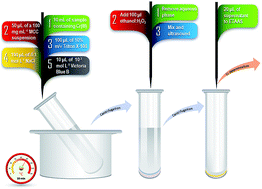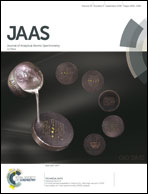Microcrystalline cellulose for the dispersive solid-phase microextraction and sensitive determination of chromium in water using electrothermal atomic absorption spectrometry†
Abstract
A small amount (5 mg) of microcrystalline cellulose dispersed in the water sample (10 mL) at pH close to neutrality retains chromium(III) ions. To obtain a complete separation and facilitate the recovery of the solid phase, Triton X-100 was added, and the mixture was heated to achieve cloud point extraction. After centrifuging and discarding the aqueous phase, the residue was treated with 0.1 mL of an ethanol : hydrogen peroxide mixture, and chromium was measured by electrothermal atomic absorption spectrometry. Since only chromium(III) is extracted in this way, speciation is feasible at low levels. The enrichment factor was 95, which resulted in a detection limit of 6 ng L−1 chromium. The relative standard deviation for the measurement in duplicate of five extractions of a 100 ngL−1 chromium solution was 5.1%. The reliability of the procedure was assessed by analyzing five water samples with a certified chromium content. Data for the speciation of these certified reference materials are also given.



 Please wait while we load your content...
Please wait while we load your content...